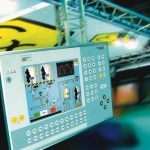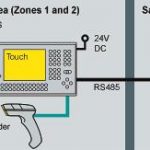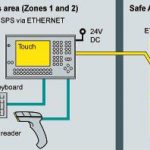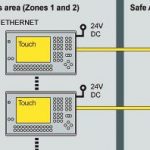PCs have been a standard feature of automation technology for many years. To take just two examples: they form the heart of any controller with software PLC functionalities and distributed I/Os and they are used as operator terminals for process plant with client-server architectures. The PC’s advantages as a hardware platform are firstly its universal availability and acceptance and secondly the abundance of suitable software packages and applications. These arguments are valid regardless of whether the preferred operating system is Windows or Unix. The number and breadth of applications for PC based hardware platforms are consequently increasing all the time.
Stefan Sittel
There is a growing demand in the process industry for more user-friendly control and display equipment to serve ever more complex and sophisticated production facilities. When it comes to visualising, controlling and monitoring processes, the display technology and the underlying control functions of the operator panels are forced to satisfy progressively tougher requirements. Project design costs play a particularly crucial role. The outcome: larger displays and colour graphics in combination with a touchscreen to enhance the convenience for the operator. Now that Windows and Unix – usually in the form of Linux – have established themselves as the target system base for all the most popular visualisation software, there is no alternative to the PC as the standardised hardware platform for operator panels in this performance class.
Ex panel PCs in the process industry
The integration of the individual operator terminals in their respective network topology is today an important aspect. Different communication interfaces have to be provided for each application. In addition to serial point-to-point communication using simple protocols or fieldbus systems, communication with Ethernet based protocols is rapidly gaining ground. When account is also taken of requirements relating to the display quality, the necessary PC hardware performance for the visualisation packages and control software, the memory capacity and the place of installation, the result is a panel PC with an integrated display. The fact that this panel PC is destined for the process industry means it must also comply with explosion protection requirements and be approved in accordance with the currently valid European Atex standards.
The PCEX 410 from Extec is a typical representative of this panel PC class for the hazardous area. This flat PC is available either in a panel-mounting version or in a surface-mounting case. With its fanless 400 MHz PC processor, 512 MB RAM, 20 GB hard disk and a standard operating system like Windows XP, it is ideally matched to the requirements of software packages irrespective of whether it is used as a local operator and display terminal, a software PLC, a network client or a web terminal. Its high-contrast 10.4“ TFT colour display featuring an intrinsically safe touchscreen for cursor control, 24 function keys with insertable label strips and LEDs, and numeric input keys makes for extremely convenient operator control of the processes to be visualised. Alphabetical inputs are possible using either function keys or a popup keyboard that is displayed on the screen at the press of a key. The aluminium front plate with short-stroke keys and polyester foil (IP 65) is specially designed for use in harsh industrial environments.
Several interfaces
The PCEX 410 panel PC integrates several communication interfaces. It has a serial RS485 or TTY interface for communicating with a controller or system over long distances. There is also a 100-Base-TX Fast Ethernet network interface to facilitate data exchange, for instance, directly with the system via TCP/IP, over the intranet with the process control system or over the internet. All these interfaces are connected via an “increased safety“ type terminal block on the back of the equipment and can thus be linked directly to the process controller in the safe area. A USB port for installing software packages on the panel PC, for instance via an external USB CD drive, simplifies the startup phase. If required, an Exi expansion keyboard, an Exi mouse and an Exi barcode reader for extended data collection can be connected to the three integrated, intrinsically safe serial ports.
Microsoft Windows XP embedded is supplied as a preinstalled operating system; other PC operating systems are possible. This broad operating system base ensures compatibility with a large number of standard application programs for visualisation, data collection, data processing, data communication, control and internet access.
The spectrum of applications open to the PCEX 410 panel PC is exceptionally diverse thanks to its approval for the hazardous area, the use of a standardised, high-power PC platform, the interface variants that can be delivered for process interfacing and the intrinsically safe peripheral interfaces.
Centrifuge control
The PCEX 410 panel PC can be used as a normal operator terminal with a serial point-to-point connection between it and the PLC, for example on a centrifuge control. The dynamic process variables are exchanged by means of an Allen-Bradley controller, for instance with the Modbus protocol via the serial RS485 port. An application which maps the process evolution using the Wonderware Scada software package as its user surface and allows the operator password-protected access to the centrifuge’s manual operating mode is installed in the PCEX 410.
Ethernet interface
In another application, operation of a truck loading station in a chemical plant is controlled by a Siemens S7 PLC. The panel PC is connected to the Profibus DP fieldbus of a Siemens PLC via an Ethernet-to-Profibus-DP bridge, to permit the necessary data exchange. Siemens ProTool/Pro is installed on the panel PC as visualisation software. A stationary, intrinsically safe barcode reader is connected directly to the PCEX 410, while a second application links the operator terminal to the automation network. This application transmits the access data, job number and product release to the process system also via Ethernet and TCP/IP for authorisation and logging. The PLC then selects the appropriate screen and outputs the product releases along with various other information to the driver of the tank truck.
Client-server application
In a production facility in the pharmaceutical industry several operator terminals are integrated in a typical client-server network. This facility is controlled by a process control system and classified as zone 1. All the terminals are connected to the control system via Ethernet and TCP/IP. The custom-designed user surface of the process control system manufacturer’s Scada system runs as an application on the PCEX 410. It was originally created by the system integrator together with the screens for the control room using the same software package. The panel PCs installed across this facility for operating and monitoring the individual production steps, several of which are manual, are clients in an Ethernet based client-server architecture. The database can be either located on the central server or distributed between several computers, depending on the parameterization of the overall system.
For hazardous areas
Reducing the local functionality of the panel PC to that of a simple network terminal in the hazardous area is another typical application that is increasingly popular today. Data is supplied to and received by operator terminals in the distributed, intranet-linked control system of a chemical plant. The operator terminals themselves launch a browser application, based on Microsoft Internet Explorer for instance, which retrieves the required screen together with the actual data directly from the network server via Ethernet and the enabled TCP/IP address. Operator control and monitoring are to all intents and purposes independent of specific locations. All that is needed is access to the intranet or internet and a suitable firewall. Depending on their ID and allocated rights, each operator sees only certain parts of their own system, all the systems in a plant or – over the internet – all plants anywhere in the world no matter how remote. The benefits for service assignments and networked production are immeasurable.
CPP 439
Share:










